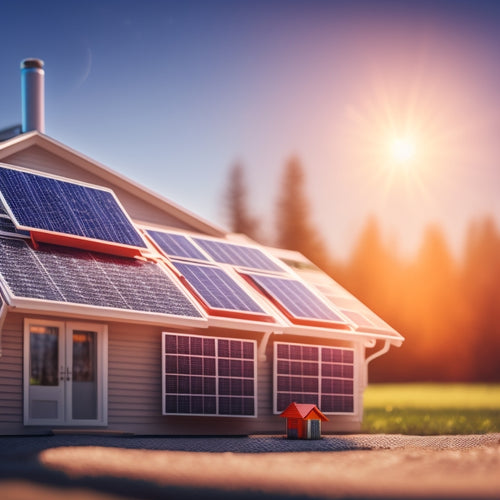
Essential Tips for Tiny House Solar Panels Installation
Share
When installing solar panels on your tiny house, focus on maximizing space and efficiency. Use high-efficiency monocrystalline panels for limited areas, as they provide the most energy per square foot. Confirm your roof faces south for ideal sunlight exposure and conduct a shading analysis to identify any obstructions. Choose mounting systems suitable for your roof type—flat or sloped; consider materials like metal or asphalt for durability. Take advantage of federal tax credits and state incentives for cost savings. Following these tips can enhance overall performance, and there's even more to investigate about optimizing your solar setup.
At a Glance
- Evaluate roof orientation; south-facing roofs capture the most sunlight for optimal energy production.
- Choose high-efficiency monocrystalline panels to maximize energy output in limited space.
- Conduct a shading analysis to identify and mitigate obstructions affecting solar panel performance.
- Ensure your roof can support the weight of the panels and mounting hardware for safe installation.
- Stay informed about federal and state tax incentives to reduce installation costs and enhance savings.
Space-Efficient Energy Solution
When you're installing solar panels on a tiny house, maximizing your roof space is essential.
By selecting higher energy density panels that provide up to 20% more energy per area, you can further enhance your energy output without overwhelming your limited area.
Compact solar designs allow you to capture energy without sacrificing aesthetics or functionality.
Maximizing Roof Space
Maximizing roof space is vital for tiny house owners looking to harness solar energy effectively. Start by evaluating your roof orientation; south-facing roofs typically capture the most sunlight throughout the day.
If your roof isn't ideally oriented, don't worry—there are mounting solutions that can improve panel placement.
Next, conduct a shading analysis. Identify any trees, buildings, or other obstructions that may cast shadows on your roof. Even partial shading can greatly reduce energy production, so it's important to verify your panels are positioned to receive maximum sunlight.
Consider the angle of your roof as well. A steeper pitch can enhance solar panel efficiency by allowing snow and debris to slide off, maintaining peak performance year-round.
Making use of every inch of available space is key. You might consider using smaller panels or flexible solar panels that can conform to irregular roof shapes.
Compact Solar Designs
Compact solar designs offer a practical solution for tiny house owners aiming to enhance energy production without sacrificing precious space. By utilizing compact panel layouts, you can maximize the efficiency of your solar installation, guaranteeing that every inch of available roof space works for you. These layouts are specifically engineered to fit snugly within limited areas, promoting effective energy capture even in confined environments.
Furthermore, innovative mounting solutions play a vital role in compact solar designs. These systems allow you to position panels at ideal angles, which is essential for maximizing sunlight exposure. Whether you opt for adjustable mounts or low-profile installations, these solutions make certain that wind resistance is minimized while maintaining structural integrity.
When considering compact solar designs, pay attention to panel specifications and energy output. Smaller panels might seem less powerful, but advancements in technology mean they can often produce more energy than older, larger options.
Ultimately, choosing compact designs not only enhances your tiny house's energy independence but also aligns with your desire for a sustainable, free lifestyle. With the right approach, you can enjoy the benefits of renewable energy without compromising your living space.
Cost Savings Over Time
Installing solar panels on your tiny house can greatly reduce your energy bills over time. Not only do you save on monthly costs, but you may also qualify for tax incentives that further enhance your financial benefits.
By evaluating your energy needs and choosing the right battery type, you can maximize your savings and efficiency in energy storage.
Smart technology aids in understanding energy consumption patterns. Understanding these savings can help you make an informed decision about your solar investment.
Reduced Energy Bills
Utilizing solar panels in your tiny house can lead to significant reductions in energy bills over time. By capturing the sun's energy, you're not just cutting costs; you're also creating the path toward energy independence.
Solar panels allow you to generate your own electricity, which means you'll rely less on the grid and avoid fluctuating energy prices.
As you invest in solar technology, you'll start to see tangible solar savings. Initially, your investment may seem substantial, but the long-term savings can be impressive. Many tiny homeowners report slashing their energy bills by 50% or more after installing solar panels.
Over the years, these savings accumulate, often paying for the installation costs and continuing to benefit you financially.
Moreover, solar panels require minimal maintenance, which means fewer unexpected expenses down the road. You're not just saving money; you're also gaining control over your energy consumption.
This newfound freedom allows you to allocate funds toward other passions, journeys, or simply enjoying a more sustainable lifestyle. Embracing solar energy is a strategic move that equips you while lightening your financial load.
Tax Incentives Benefits
When you decide to invest in solar panels for your tiny house, you can take advantage of various tax incentives that greatly enhance your cost savings over time. One of the most significant benefits is the federal tax credit, which allows you to deduct a substantial percentage of your solar installation costs from your federal taxes. Currently, this credit can cover up to 26% of your expenses, making it easier to offset your initial investment.
In addition to federal credits, many states offer their own rebates and incentives that can further reduce the financial burden. These state rebates vary by location but can provide significant cash back or additional tax deductions. By researching and applying for these programs, you can maximize your savings.
Moreover, when you combine these incentives with reduced energy bills and potential increases in your property value, the long-term financial benefits become even more persuasive.
It's crucial to stay informed about the specific incentives available in your state and consult with a tax professional to guarantee you're capturing all possible savings. Embracing solar energy not only promotes freedom from utility companies but also supports your financial independence.
Panel Efficiency Ratings
When choosing solar panels for your tiny house, understanding efficiency ratings is vital for maximizing energy output.
It's also important to evaluate brands like Tesla, LG, and Panasonic for quality solar panel systems, as they often come with warranties that guarantee reliability and performance.
You'll want to compare different panel technologies, as each type has distinct metrics that affect performance and suitability for your specific needs.
Understanding Efficiency Metrics
Understanding the efficiency of solar panels is vital for making informed decisions about your tiny house energy system. The efficiency metric indicates how effectively a panel converts sunlight into usable electricity. Higher efficiency ratings mean you'll need fewer panels to meet your energy needs, which is important in a space-limited tiny house.
When exploring solar panel types, you'll find monocrystalline, polycrystalline, and thin-film options. Monocrystalline panels typically boast the highest efficiency, ranging from 15% to 22%, making them ideal for compact installations. Polycrystalline panels are slightly less efficient but often more affordable. Thin-film panels, while easier to install, generally offer lower efficiency, so consider your energy requirements carefully.
To optimize your installation, adhere to established installation guidelines. Proper positioning and angle can greatly enhance energy capture, even with lower-rated panels. Remember, the goal is to maximize your freedom in your tiny house lifestyle while ensuring you have sufficient power.
Ultimately, understanding these efficiency metrics helps you select the right solar panel type that aligns with your energy goals, space constraints, and budget. This knowledge enables you to create a sustainable and autonomous living environment.
Comparing Panel Technologies
How do you choose the right solar panel technology for your tiny house? Start by comparing the efficiency ratings of different panel types: monocrystalline, polycrystalline, and thin-film.
Monocrystalline panels are the most efficient, often exceeding 20%, which means they generate more power in less space. This advantage is essential in tiny homes where every square foot counts. However, they come at a higher price.
Polycrystalline panels are slightly less efficient, typically around 15-17%, but they're more affordable and have a decent panel lifespan. If budget constraints are a concern, these panels can still meet your energy needs without breaking the bank.
Thin-film panels offer flexibility and lightweight options, which can help reduce installation challenges, especially on unconventional roofs. However, their efficiency is lower, generally around 10-12%, so you'll need more surface area to produce the same power.
Consider these factors carefully. The right choice balances efficiency, cost, lifespan, and your specific energy needs.
Assess how each technology fits within your tiny house lifestyle and energy independence goals, ensuring you make an informed decision to maximize your solar investment.
Selecting Based on Roof Type
When choosing solar panels for your tiny house, the type of roof you have plays a vital role.
Flat roofs often require specialized mounting systems to optimize energy capture, while sloped roofs typically allow for better drainage and natural sunlight exposure.
To guarantee reliability and prevent potential malfunctions, it's important to assess the integration of key components of off-grid solar systems that best suit your roof type.
Understanding these aspects guarantees you make an informed decision that maximizes your solar investment.
Flat Roof Considerations
Flat roofs present unique challenges and opportunities for solar panel installation, making it crucial to reflect on the roof type before proceeding.
When you're working with a flat roof, it's essential to evaluate the flat roof materials used in its construction. Common materials include EPDM rubber, TPO, and PVC, each influencing the installation techniques you'll employ.
For instance, if your flat roof is made of EPDM, you might need specialized mounting systems to guarantee the panels are secure and optimized for sunlight exposure. Conversely, TPO roofs often allow for ballasted systems that can simplify installation.
Moreover, you must account for drainage and potential water pooling, as flat roofs can lead to issues if not managed properly. Confirm that your solar panel installation doesn't obstruct drainage pathways, which could cause leaks or damage over time.
Always consult a professional who understands the subtleties of flat roof solar panel installation to assure efficiency and longevity.
Sloped Roof Advantages
Choosing a sloped roof for your tiny house can markedly enhance the efficiency of your solar panel system. The angle of a sloped roof allows for ideal sunlight exposure, particularly in regions with varying sun angles throughout the year.
By selecting the right roofing materials, like metal or asphalt shingles, you can improve durability while reducing potential shading issues that may arise with flat roofs.
When considering installing solar panels, think about the structural integrity of your sloped roof. It needs to support the weight of the panels and any mounting hardware. Confirm that your roofing materials are compatible with solar installations, which can prevent leaks and prolong the lifespan of both your roof and the solar system.
Another advantage is the natural drainage offered by sloped roofs. Rainwater can easily run off, preventing water pooling that could lead to roof damage or reduced solar panel performance.
Lastly, a sloped roof can provide aesthetic appeal, complementing your tiny house's design while maximizing energy independence.
Environmentally Friendly Energy Source
When you choose solar panels for your tiny house, you're opting for a renewable energy source that greatly reduces your carbon footprint.
These panels utilize sunlight, a resource that's abundant and sustainable, making them an eco-friendly choice.
Renewable Energy Benefits
How can you make use of solar energy to benefit the environment? By installing solar panels on your tiny house, you're making a significant step towards a sustainable lifestyle.
Solar energy is a clean, renewable resource that reduces your carbon footprint. Unlike fossil fuels, it doesn't emit harmful greenhouse gases, contributing to cleaner air and a healthier ecosystem.
With solar panels, you gain energy independence. You're no longer tethered to utility companies, which often rely on non-renewable energy sources. This independence not only enables you but also decreases the demand for fossil fuels, helping to preserve our planet for future generations.
Moreover, the installation of solar panels can lead to reduced energy costs. As you tap into the sun's energy, you'll notice lower electricity bills, freeing up resources for other sustainable practices.
This financial benefit enhances your ability to invest in further eco-friendly upgrades for your tiny home.
Frequently Asked Questions
How Do I Determine My Energy Usage for Solar Sizing?
To determine your energy usage for solar sizing, start energy monitoring your appliances. Conduct a usage assessment by tracking consumption over time, ensuring you accurately gauge your needs and maximize your system's efficiency for greater freedom.
Can I Install Solar Panels Myself or Hire a Professional?
Did you know that over 80% of solar panel installations are done by professionals? While DIY installation can save money, hiring professional services guarantees efficiency and adherence to safety standards, giving you the freedom to enjoy your energy independence.
What Permits Are Required for Tiny House Solar Installations?
You'll need to check local zoning regulations and installation guidelines before installing solar panels. These permits guarantee your setup meets safety standards and legal requirements, helping you create a sustainable energy source for your tiny house.
How Do Weather Conditions Affect Solar Panel Performance?
Weather conditions greatly affect solar panel performance. High temperatures can reduce solar efficiency due to overheating, while cold can enhance it. Understanding temperature impact helps you optimize your system for consistent energy production and freedom in energy independence.
What Is the Lifespan of Tiny House Solar Panels?
Tiny house solar panels typically last 25-30 years with proper solar panel maintenance. Regular upkeep enhances energy efficiency, ensuring you maximize your investment, enjoy freedom, and minimize reliance on traditional power sources throughout their lifespan.
Explore More
By utilizing the sun's power, you're not just cutting costs; you're changing your tiny home into an efficient energy oasis. Visualize sleek panels glistening atop your roof, soaking in sunlight while powering your daily life. With careful selection based on your roof type and understanding efficiency ratings, you're setting the stage for sustainable living. Accept this eco-friendly solution, and watch as your energy bills shrink, leaving you with more resources to enjoy your cozy, tiny haven.
Related Posts
-

Top Eco-Friendly Camping Equipment for a Sustainable Adventure
When you're camping with the planet in mind, opt for eco-friendly gear like tents made from recycled materials and bi...
-

A Beginner's Guide to Navigating the Solar Investment Tax Credit
You're eligible to claim a significant Solar Investment Tax Credit (ITC) of 30% of total installation costs, but mane...
-

Solar Powered Lights for Sustainable Home Decor
Solar-powered lights offer a stylish and eco-friendly way to enhance your home decor. They capture sunlight, converti...


